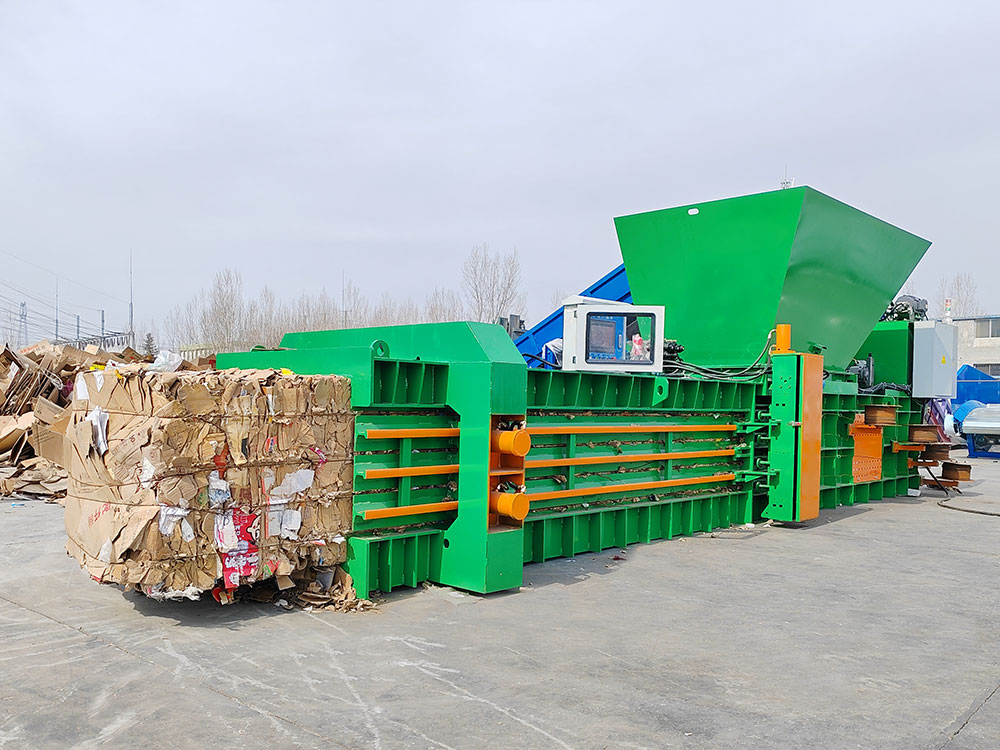Factories face a profit drain. Hidden scrap handling costs eat into revenue unexpectedly. A horizontal hydraulic baler solves this efficiently. It crushes storage and transport expenses.
Installing a horizontal hydraulic baler saves factories 30-40% storage space and cuts material handling frequency, generating $50k-$150k yearly scrap revenue. Most achieve ROI within 12-18 months while meeting strict ESG compliance standards in North America and Japan.

When scrap piles up, costs mount silently. But smart factories now fight back with hydraulic solutions. Let me show you how these machines transform waste management.
What is a hydraulic baler?
Waste terminology confuses buyers. Definitions vary globally. Western buyers expect full automation while Asian factories often accept semi-automatic models. This gap creates purchasing mistakes.
A hydraulic baler uses pressurized fluid to compress waste into dense bales. Unlike mechanical systems, it delivers stable force up to 400 tons, excelling for continuous industrial use while trending toward smart PLC controls with remote monitoring features for modern factories.
Why hydraulic beats other compression methods
There’s confusion about compression technologies. Let’s break it down clearly:
| Compression Type | Force Capacity | Ideal Use Case | Factory Fit |
|---|---|---|---|
| Hydraulic Press | 50-400 tons | Continuous production | Paper/plastic recycling |
| Mechanical Screw | 10-80 tons | Intermittent operation | Small workshops |
| Pneumatic System | 5-30 tons | Light packaging | Retail centers |
I’ve seen factories choose wrong systems. One Canadian client used pneumatic presses for cardboard. They jammed daily. After switching to our hydraulic solution:
- No More Downtime: 16-hour continuous runs became routine
- Higher Density: Bales weighed 25% more, increasing scrap revenue
- Automation Ready: PLC integration allowed remote troubleshooting
The shift toward intelligent balers is accelerating. Modern units include:
- Real-time pressure monitoring
- Automatic safety cutoffs
- Production data logging
Considering upgrades? Message our engineers for machine compatibility checks. Don’t risk mismatched equipment.
What is the purpose of a baler?
Factories often see balers as waste compactors. This limited view misses strategic value. Actually, they’re profit multipliers across departments.
Modern balers transform waste management into profit centers by cutting transport costs by 40-60%, enhancing warehouse safety through 5S organization, and increasing scrap value with denser bales that attract premium recycling rates across industries.

Industry-by-industry baling advantages
Each sector uses balers differently. Observe the contrasts:
| Industry | Key Application | Savings Focus | Special Requirements |
|---|---|---|---|
| E-commerce Fulfillment | Return Processing | Space reduction (45%+) | Fast cycle times |
| Paper Mills | Trim Waste Recycling | Scrap revenue generation | Moisture-resistant cylinders |
| Logistics Centers | Packaging Material Recovery | Dock congestion relief | High-throughput automation |
Let’s examine real impacts. A Japanese appliance maker installed our units. Their warehouse manager reported:
- Forklift movements dropped 70% eliminating aisle blockages
- Safety incidents fell to zero with organized bale storage
- Scrap dealers paid 15% more for uniform bales
Increasingly, North American plants list balers in CSR reports. One client documented 380 tons CO2 reduction annually. That impresses auditors and buyers alike.
Your industry has unique needs. Send us your specs for custom compression solutions.
Is a cardboard baler considered machinery?
Purchase classifications matter. Some buyers mistake balers for simple tools. Regulatory reality differs especially in developed markets.
Cardboard balers meet legal machinery definitions requiring CE/ISO certifications in North America and Japan. They qualify as capital assets allowing depreciation benefits while demanding scheduled maintenance and safety protocols like any industrial equipment.

Machinery classification breakdown
Three factors determine equipment status globally:
Safety Compliance Requirements
- CE Mark mandatory for EU imports
- OSHA compliance essential in US facilities
- Annual pressure vessel inspections
| Financial Treatment | Attribute | Consumable Tool | Capital Machinery |
|---|---|---|---|
| Depreciation | No | 5-7 year schedule | |
| Maintenance Cycles | Irregular | Quarterly servicing | |
| Operator Training | Basic | Certified programs |
Operational Risks
I recall an incident where uncertified balers caused problems. A Quebec distributor imported "tools" without safety features. Result:
- Penalties from labor inspectors
- Production halt during retrofits
- $28,000 in unexpected compliance costs
Proper machinery classification protects your business. We provide full documentation packages with every machine including:
- Test certificates
- Spare parts lists
- Safety manuals
Need certification guidance? Our team verifies requirements for your country.
What is the use of hydraulic baling press machine?
Material versatility opens revenue streams. While most know cardboard applications, modern presses handle diverse materials creating unexpected opportunities.
Hydraulic baling presses process cardboard, plastics, textiles and e-waste, cutting volumes by 80% while enabling resale. Future models feature auto-tying systems and energy monitoring for compliance with tightening global emissions regulations.

Emerging industry applications
Let’s explore growth sectors:
| Waste Stream | Compression Ratio | Value Creation | Market Trend |
|---|---|---|---|
| PET Bottles | 12:1 | Flake premium pricing | New bottle-to-bottle recycling |
| Agricultural Film | 8:1 | Cleaner recyclate output | EU circular economy push |
| E-Waste Casings | 10:1 | Heavy metal containment | WEEE compliance focus |
Production innovations matter. A Singaporean electronics recycler achieved:
- $120,000/year extra revenue from compacted ABS plastic
- 30% lower shipping costs via container optimization
- Energy use tracking for sustainability reporting
The market evolution demands smarter equipment. Next-generation balers will offer:
- Automatic bale size adjustment
- RFID material tracking
- Predictive maintenance alerts
Exploring new waste streams? Request material testing on your samples.
Conclusion
Horizontal hydraulic balers cut factory costs by reducing waste handling expenses while generating scrap revenue and ensuring environmental compliance critical for exports.








